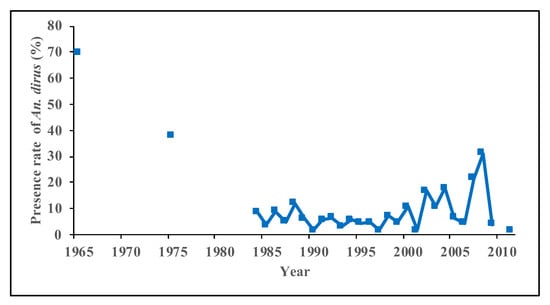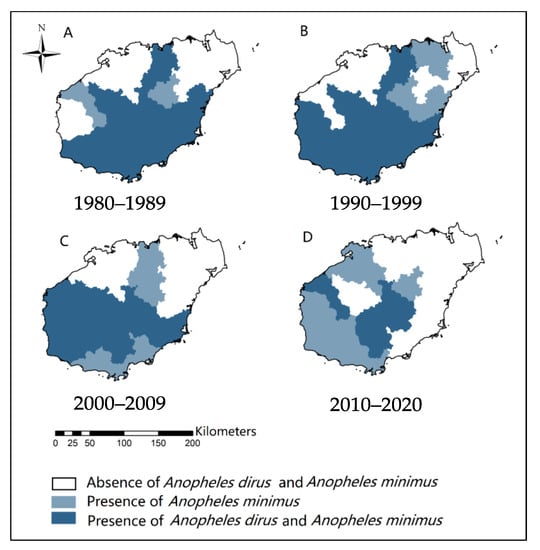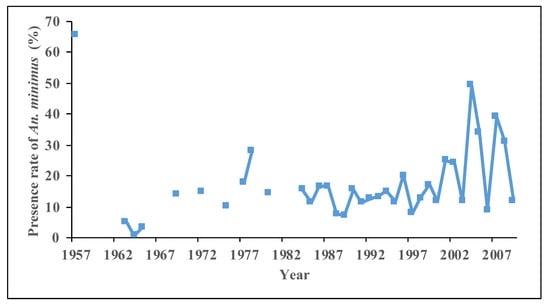Your browser does not fully support modern features. Please upgrade for a smoother experience.
Please note this is an old version of this entry, which may differ significantly from the current revision.
Subjects:
Entomology
Malaria is a serious mosquito-borne tropical disease impacting populations in tropical regions across the world. Malaria was previously hyperendemic in Hainan Province. Due to large-scale anti-malarial intervention, malaria elimination in the province was achieved in 2019. Anopheles dirus and Anopheles minimus are primary malaria vectors, mainly distributed in the southern and central areas of Hainan.
- vectors
- research
- Hainan Province
1. Species and Distribution
A total of 32 species of anopheline mosquitoes have been recorded in Hainan Province [10]. An. dirus and An. minimus have been confirmed as the principal malaria vectors in Hainan Province, according to a biological investigation of various anopheline mosquitoes and the epidemiological characteristics of malaria. These two species meet all criteria of vector incrimination in Hainan, including (1) evidence that temporal and spatial distribution of local human malaria cases is dependent on An. dirus/An. minimus [4,7,59], (2) evidence of a high degree of anthropophily in An. dirus/An. minimus [7,44,48,57], (3) evidence that Plasmodium sporozoites can be harbored in the salivary glands of An. dirus/An. minimus under natural conditions [4,7,16,48], and (4) evidence that the Plasmodium parasite harbored by An. dirus/An. minimus can be transmitted under experimental conditions [49,50,51].
An. sinensis, An. candidiensisand and An. philippinensis harbor malaria sporozoites in their salivary glands in Hainan, with sporozoite rates of 0.02, 0.21, and 0.06, respectively [7]. However, they are considered secondary malaria vectors because they have a lower degree of anthropophily in Hainan.
An. lesteri, one of the main malaria vectors in other provinces in China, is distributed in Wenchang, Haikou, and Wanning. It is not a malaria vector in Hainan, as no malaria sporozoites were found in its salivary glands [8,14,17,42,43,46,47].
2. An. dirus
Anopheles dirus s.s. and Anopheles baimaii, belonging to the Anopheles dirus complex, are important malaria vectors [81]. Results from previous research indicate that An. dirus in Hainan is a specimen of the species Anopheles dirus s.s. [18,19,26,30].
An. dirus is an exophilic mosquito and prefers to suck human blood [82]. It accounts for 0.02% to 0.54% of the composition of Anopheles mosquitoes in human rooms in the daytime [82]. However, it accounts for 3.8% of the composition of Anopheles mosquitoes when human plus cattle bait was used in the nighttime [7].
In Hainan Province, its larvae breed in riverbeds and rocky caves where there is shade, and decaying leaves [7]. A survey on the distribution of An. dirus from 1965 to 1975 indicated that An. dirus was mainly distributed in mountainous areas, especially in the south-central part of Hainan Island [11,12,25,26,31,33,34,35,40]. Due to its breeding habits, environmental modifications, such as cutting down shrubbery, or land use change can lead to the reduction in An. dirus [15,18,22,25,28,38,40,41].
Results on malaria vectors over the last 70 years indicate that the population and distribution of An. dirus are decreasing [5,15,20,25,28,29,38,40,41]. Longitudinal surveillance in Qiongzhong shows a significant decreasing trend in the population of An. dirus, with 1.67 per night in 2005 to 0.03 per night in 2014 [44]. It is now difficult to catch An. dirus at this site. In another surveillance site in Wuzhishan, the population of An. dirus decreased from 1.17 per night in 2005 to 0.33 per night in 2014 [44]. Vector surveys during seasonal anti-malarial programs showed a gradual and significant decrease in the presence of An. dirus in Hainan (Figure 3). It means that the spatial distribution of An. dirus is shrinking. The number of cities/counties with An. dirus decreased from 10 in 1981–1990 tofour during 2011–2020 (Figure 4). The decrease in the An. dirus population may lead to the disappearance of this species in certain counties and cities in Hainan. At present, An. dirus is mainly distributed in mountainous areas, including Changjiang, Wuzhishan and Qiongzhong.

Figure 3. Presence of Anopheles dirus in Hainan Province in seasonal anti-malarial programs from 1965 to 2011.

Figure 4. Presence of Anopheles minimus and Anopheles dirus in Hainan Province in seasonal anti-malarial programs from 1980 to 2020. (A) From 1980 to 1989; (B) from 1990 to 1999; (C) from 2000 to 2009; (D) from 2010 to 2020. The light blue color means presence of Anopheles minimus, and the dark blue color means the presence of both kinds of Anopheles.
3. An. minimus
An. minimus can be classified into A and B types in Hainan, based on ecological and morphological surveys and controlled trials [7,57]. Type A is an endophilic mosquito that prefers to rest in living rooms and is extremely sensitive to DDT [16]. However, type B is an exophilic mosquito that prefers to rest outside and avoids surfaces with DDT, but demonstrates excitement when contacting DDT. Results from PCR testing indicated that An. minimus populations from Wenchang and Wanning were An. minimus A [27].
An. minimus prefers human and cattle blood. An. miminus is the dominant species of domestic mosquito, accounting for 37.1% of anopheline mosquitoes in human rooms in the daytime [7].
An. minimus breeds in clear water bodies, with less humus shaded by plants, such as small streams, slow-flowing rivers, irrigation ditches with water plants, stagnant water in riverbeds, and so on [16]. An. minimus was previously widely distributed in mountainous, hilly, and coastal plain areas over the whole province in the 1950s [7,9].
An. minimus was previously distributed across Hainan Island, but the presence of An. minimus has changed dynamically [10,11,13,15,20,21,23,24,27,28,31,32,33,34,35,36,37,38,39,41,44,45]. Since the use of IRS with DDT to control malaria mosquitoes in 1959, the distribution of An. mimimus has shrunk dramatically. A survey from 1963 to 1965 showed that An. minimus had been almost eradicated [3]. However, results from a survey in 1978 showed that An. minimus had rebounded (Figure 5) [3,7]. However, the presence of An. minimus was at a stable rate of 11% to 26% in most years after 1978 (Figure 5). It means that An. minimus is hard to eliminate naturally in a given region although there was a greater improvement in socio-economic development and large-scale implementation of vector control interventions. Vector surveys during the seasonal anti-malarial program from 1980 to 2020 indicate that the percentage of presence of An. minimus at various sites is around 30%, and the number of counties/cities with An. minimus decreased from 12 in 1980–1989 to nine in 2010–2020, mainly distributed in the south-central and western areas of Hainan Province (Figure 4). To further clarify the distribution of An. minimus in Hainan Province, a special survey was conducted throughout the island from 2011 to 2015. Results showed that among 56 survey sites in 18 cities and counties, An. minimus was distributed in 17 survey sites in nine cities/counties (Figure 6). An. minimus was not recorded in coastal plain areas but in hilly and mountainous areas during this survey.

Figure 5. Presence of Anopheles minimus in Hainan Province in seasonal anti-malarial programs from 1965 to 2011.

Figure 6. Presence and absence of Anopheles minimus in Hainan Province from 2011 to 2015. Red circles indicate sites with the presence of Anopheles minimus, while blue triangles indicate sites with the absence of Anopheles minimus.
Studies on the species and distribution of primary malaria vectors are the main research topic in Hainan. In certain areas, data on species and the distribution of primary malaria vectors can provide scientific evidence for the implementation of vector control interventions. Vector control interventions should be implemented to stop malaria transmission in malaria foci with primary vectors. In Hainan, vector control interventions should be implemented to stop malaria transmission when malaria cases are reported in the central and southern mountainous areas of Hainan, where the primary malaria vectors An. minimus and An. dirus are still present.
This entry is adapted from the peer-reviewed paper 10.3390/tropicalmed8030131
This entry is offline, you can click here to edit this entry!
